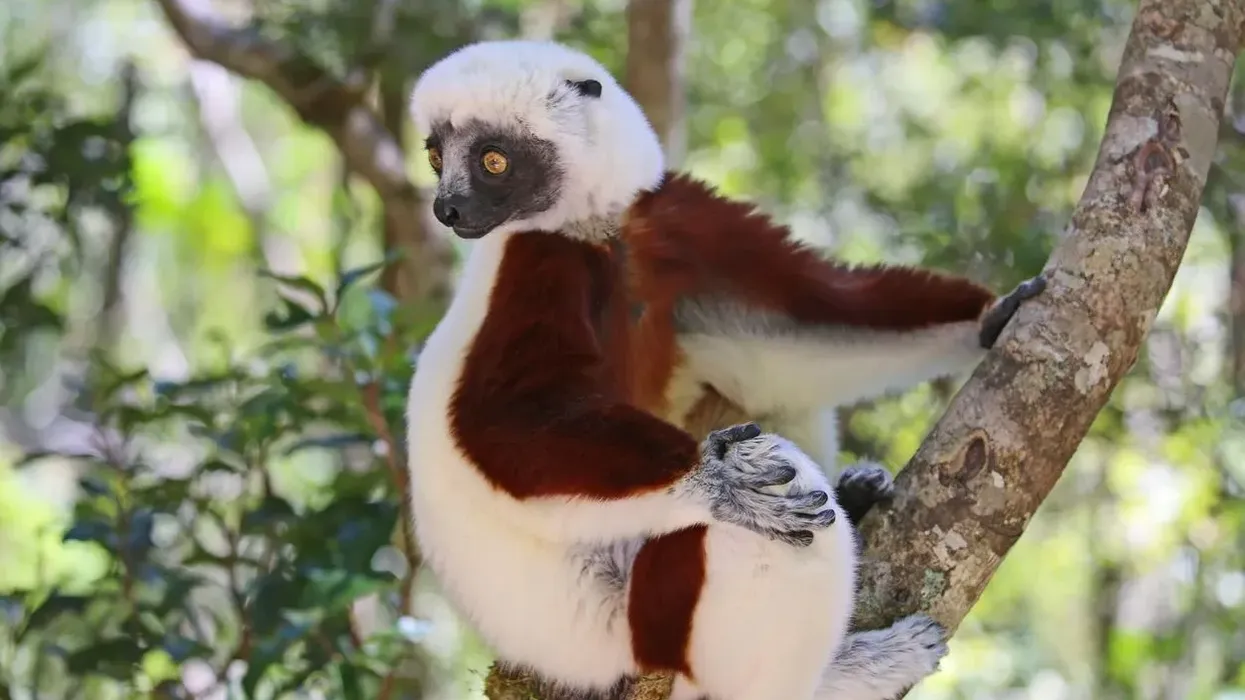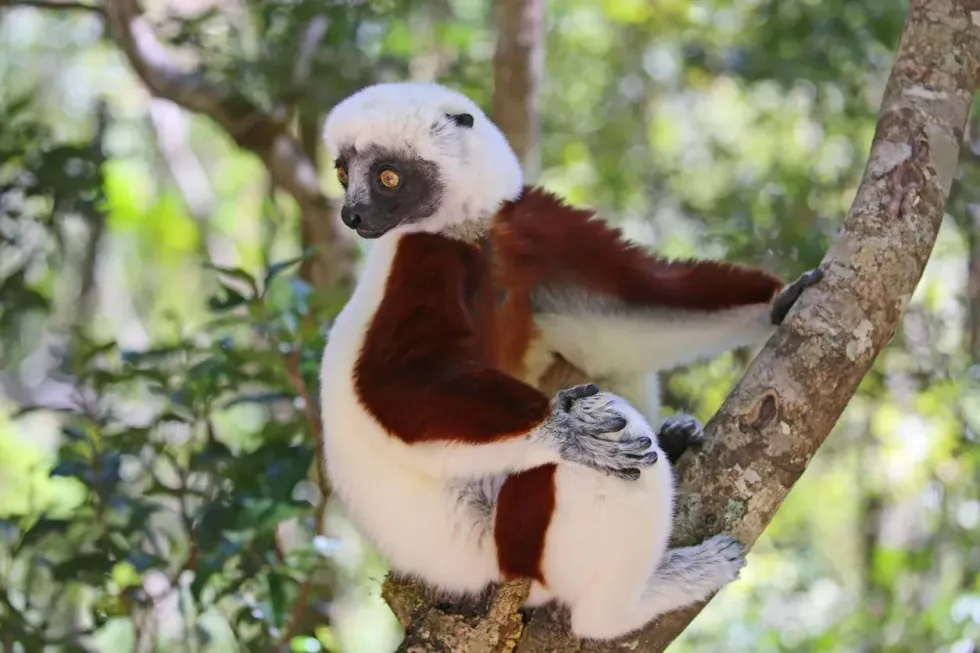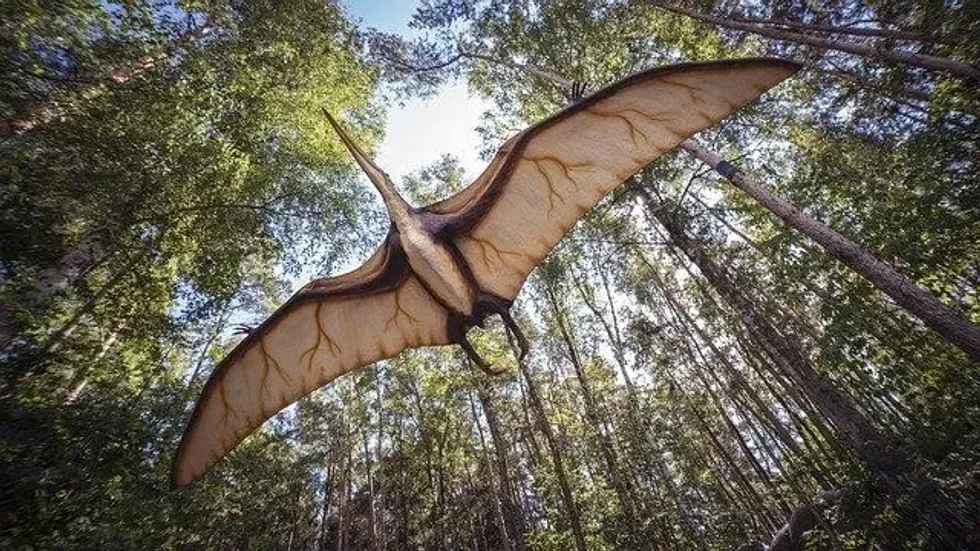Coquerel's sifaka is a medium-sized lemur living in Madagascar's northwest region. Like lemurs, their whole body is covered with white fur and patches of chestnut brown fur on the arms, legs, and chests.
The sifaka, Propithecus coquereli, belongs to the same genus as Verreaux's sifaka. However, Verreaux's sifaka has a different appearance.
The Verreaux's sifakas' whole body is covered with white fur, except patches of brown fur on the back of their head, and they like to sunbathe, relaxing on the top of the trees. They are also known for their leaping abilities, and their only means of movement on the ground is hopping.
The sifaka's population's habitat is under threat due to the cutting down of forests and hunting. As they are critically endangered, we must protect these primates and their habitat. It is never too late to organize conservation programs to save these animals.
Have you watched the movie Madagascar? Then you must have seen the lemurs. There are many species of lemur found in Madagascar. If you loved the lemurs in the movie, read these interesting facts about Coquerel's sifaka! Also, check out the fun facts about uakari and squirrel monkeys once you're done.
Coquerel's Sifaka Interesting Facts
What type of animal is a Coquerel's sifaka?
The Coquerel's sifaka is a lemur and is a diurnal and arboreal animal. They live in social groups of 3-10 individuals following the matriarchal system where females dominate.
Diurnal are those who are active in the daytime and sleep at night. The Coquerel's sifakas wake up early in the morning before sunrise and go in search of their food. They feed themselves till noon and after that rests till mid-afternoon.
Arboreal is classified as those animals that live on trees. The Coquerel's sifakas live on trees and climb using the vertical clinging and leaping method to jump from one tree to another.
Sometimes they are found on the ground moving by skipping with their two hind legs in a sideways position. So, the sifaka lemurs are known for their leaping abilities and hops to move on the ground.
What class of animal does a Coquerel's sifaka belong to?
The Coquerel's sifakas belong to the class Mammalia and the family Indriidae. Its scientific name is Propithecus coquereli.
How many Coquerel's sifakas are there in the world?
The population size of Coquerel's sifakas around the world is 200,000. However, humans' habitat destruction and hunting pose a significant threat to the constant decrease in population size.
Where does a Coquerel's sifaka live?
The Coquerel's sifakas live in the woods and forest. The dry deciduous and coastal forests of Madagascar. They are widely distributed from the Betsiboka River up to the Maevarano River.
What is a Coquerel's sifaka's habitat?
The Coquerel's sifaka, Propithecus coquereli, are forest inhabitants living in the dry deciduous forest, lowland forests, and coastal mangroves.
Since they are arboreal animals, they live on trees. They climb trees using the strength of the back legs. This method is referred to as the vertical clinging and leaping method. The habitat of the lemurs is one of the protected areas of Madagascar.
Who do Coquerel's sifakas live with?
The Coquerel's sifaka lemur live in packs. They are often found to live in small social groups ranging from 3-10 individuals of males and females. The group members do all the activities together, like sleeping and searching for food.
The female Coquerel's sifaka is dominant over the males. The males wait for the females and the infants to have access to the food first. Often the females are found to browse the area of a tree first, and the males wait patiently. If the males move to get a bite, they might be smacked by the females.
How long does a Coquerel's sifaka live?
According to sources, the Coquerel's sifaka lifespan is believed to be between 27-30 years. At the Duke University's Lemur Center, the oldest Coquerel's sifaka is found to live for 31 years old.
How do they reproduce?
The female Coquerel's sifaka may choose to mate with only one male or many males (known as polyandry) from within the group or outside of the group. It means that all the sifaka males are involved with a single female and will help her raise the baby Coquerel's sifaka.
They give birth to only a single baby, lemur, once a year.
The mating season usually occurs between November and February; that is in the wet season. The baby lemurs are born after 162 days (five to six months) during the dry season (June to July).
It weighs around 3-4 oz (85-113.4 g), and they cling to the chest of their mother for a month. When they are six months of age, they are independent. Both males and females are sexually mature when they are two to three and a half years old.
What is their conservation status?
According to the IUCN Red List, the Coquerel's sifaka's conservation status is a Critically Endangered species. The lemurs live in the forests. Due to the destruction of the forest habitat and hunting activities in Madagascar's northwest region, the Coquerel's sifaka (Propithecus coquereli) lemurs' population is slowly decreasing and are considered an endangered species.
Coquerel's Sifaka Fun Facts
What do Coquerel's sifakas look like?
The Coquerel's sifaka (Propithecus coquereli) is one of lemur species. Since they are primates, they are more primitive than monkeys.
These species are medium-sized animals with long tails. The whole body of the sifakas is covered in white fur. Only a portion of the chest, legs, and arms are covered in brown chestnut patches. The whole face is covered with black fur, except a part of the nose is comprised of white fur. They have large yellow eyes. Its lower teeth comprise the toothcomb for peeling the fruits and sometimes grooming.
How cute are they?
The Coquerel's sifaka is a super adorable cute-looking lemur living in northwest Madagascar's forests. They look like soft toys with white fur covering their whole body with patches of chestnut brown fur on the legs, arms, and chest. They have large attractive yellow eyes like those of the soft toy eye buttons.
How do they communicate?
The Coquerel's sifaka lemurs make a 'shi-fak' sound when they see a predator entering their territorial grounds. Other communication signals are olfactory, visual, and auditory.
The 'shi-fak' sound is specially made to warn their group members. The visual signal comprises the head jerking in a backward direction. The sifaka's population lives in small groups. If the group members get separated, they use their auditory signal, low grunts, and echoing howls.
In the olfactory signal communication method, the Coquerel's sifaka lemurs depend on smell. The males leave a scent on the trees using their throat glands (the gular sac), whereas the females use the anogenital glands to leave scent marks on the trees.
How big is a Coquerel's sifaka?
The Coquerel's sifakas are medium-sized lemur species. Its body length is 17-24 in (43-61 cm) tall. They are two times smaller than the Babakoto lemur, which is 35 in (90 cm) in height and weighs around 7-10 lb (3-4.5 kg). The Babakoto is the most prominent lemur species found in Madagascar.
How fast can a Coquerel's Sifaka move?
The Coquerel's Sifakas can move very fast. They are known as 'leaping lemurs'. They leap from one tree to another using their hind legs and climb the trees using their back legs. The Coquerel's sifakas can jump from one tree to another at an average height of 40 ft (12.2 m).
How much does a Coquerel's sifaka weigh?
The Coquerel's sifakas weigh around 8.2-9.5 lb (3.7-4.3 kg).
What are their male and female names of the species?
There are no specific names for the male and female of the species. The males are known as 'male Coquerel's sifakas', and the females are known as 'female Coquerel's sifakas'.
What would you call a baby Coquerel's sifaka?
The baby Sifakas are known as a 'baby Coquerel's sifaka'.
What do they eat?
The Coquerel's sifakas are herbivores; which means these primates eat only plants. Their diet comprises flowers, fruit, bark, and deadwood. They depend on a fibrous diet.
The sifakas' food habit varies depending on the season. During the dry season, the food they love to eat includes buds and mature leaves. During the wet season, the sifakas feed on flowers, young leaves, fruit, bark, and deadwood.
Are they aggressive?
The Sifakas live in matriarchal groups. The females are dominant over males. The females show aggressive characteristics towards the males.
If a male is disobeying, the female may hit or bite him. The male shows his submissive behavior by making soft sounds, showing his teeth with a facial expression, and rolling his tail between the legs before moving out of sight. Aside from this, they are a harmless lemur species.
Would they make a good pet?
Yes, in theory, they would make a good pet since they are not harmful to humans. They are medium-sized animals, and their diet comprises flowers, fruits, leaves, and tree bark. However, the sifakas are wild animals who are Critically Endangered, therefore they should be left undisturbed in their natural habitat.
Did you know...
According to Malagasy folklore and mythology, the sifakas, in the past were considered as 'sacred sun worshippers.'
The Coquerel's sifaka predators include the fossa (a ground weasel), hawks, snakes, and feral dogs.
The sifaka lemurs have two tongues - one to eat and drink, and the other is hidden behind the first. The second tongue is known as the grooming tongue.
The sifakas also have particular adaptations like toothcomb and toilet claw used for grooming.
As they are endangered animals, captive breeding for this species is practiced in Duke Lemur Center.
How to pronounce Coquerel's sifaka?
According to Malagasy pronunciation, the Coquerel's sifakas are pronounced as 'cockrels shee-fak'. Their name is based on the 'shee-fak' sound made to warn their group members against their predators.
What group are Coquerel's sifakas in?
The sifakas are diurnal primates belonging to the genus Propithecus and the family Indriidae. Within Indriidae, there are 19 species divided into three genera, Genus Indri, Genus Avahi, and Genus Propithecus.
The sifakas belong to the Propithecus verreauxi group. The Propithecus verreauxi coquereli was once a sub-species of Verreaux's sifaka, but the Coquerel's sifaka has fully evolved as separate species.
Here at Kidadl, we have carefully created lots of interesting family-friendly animal facts for everyone to discover! Learn more about some other mammals including binturong, or ring-tailed lemur.
You can even occupy yourself at home by drawing one on our cute lemur coloring pages.









